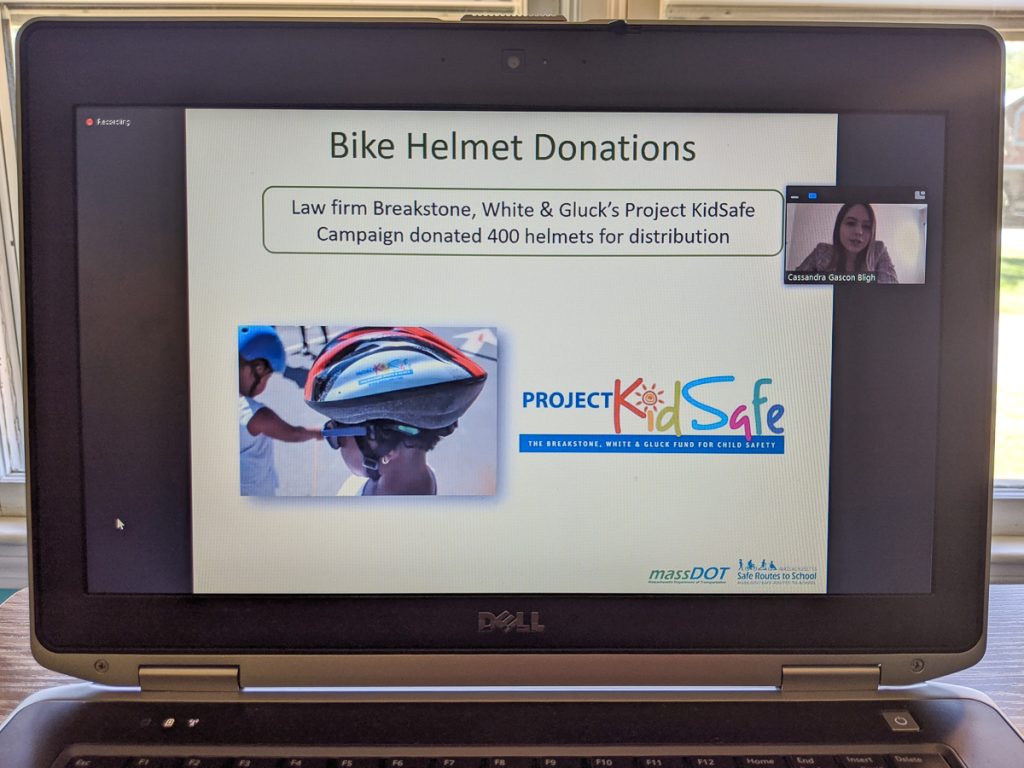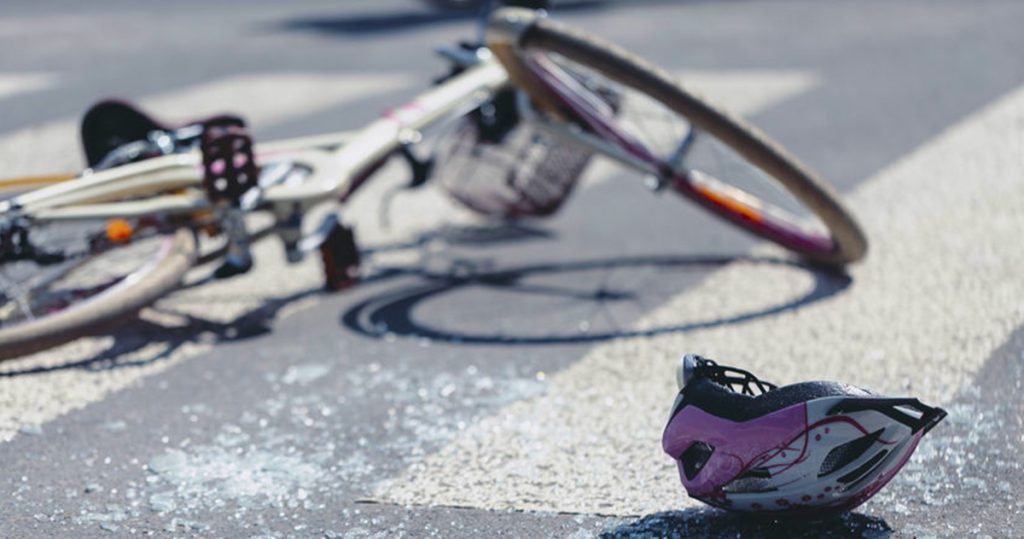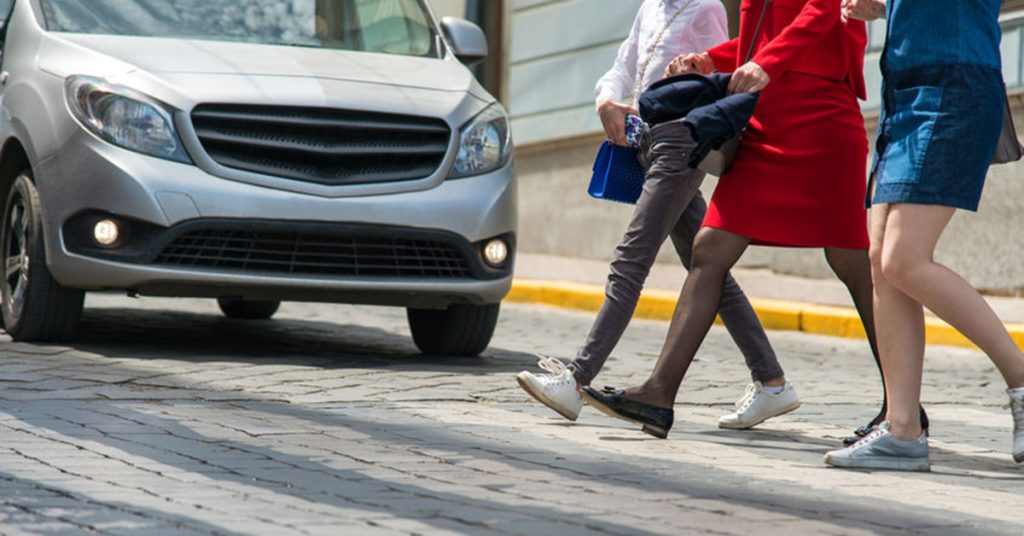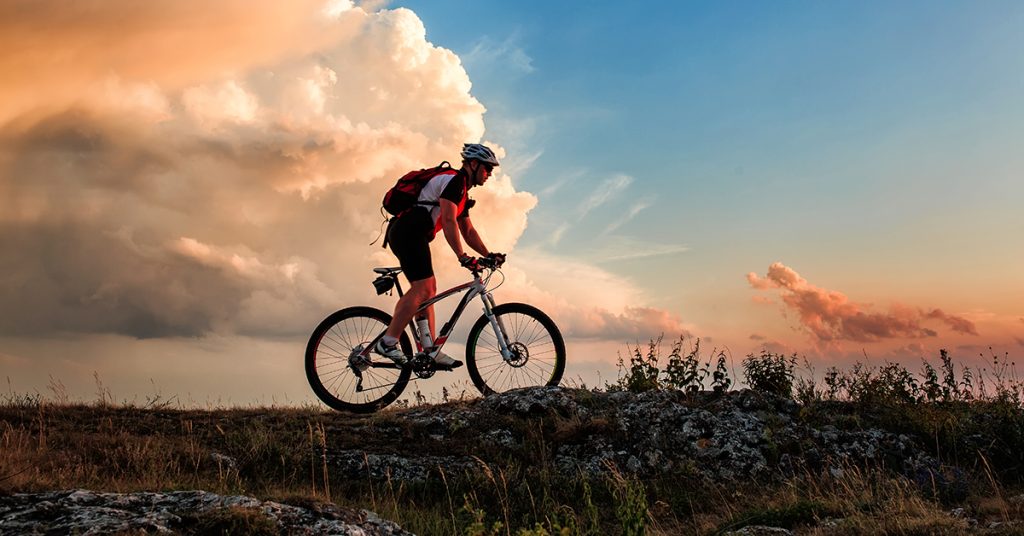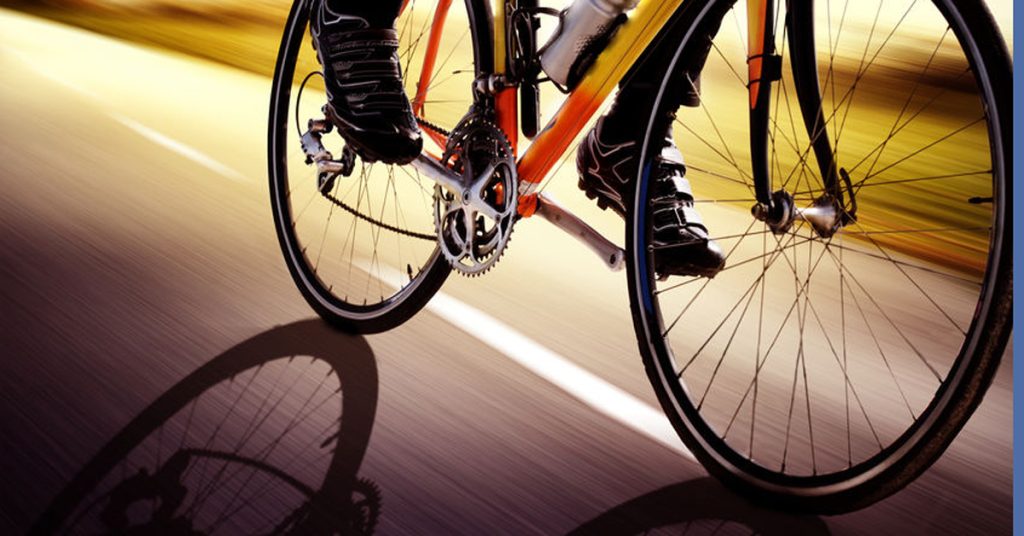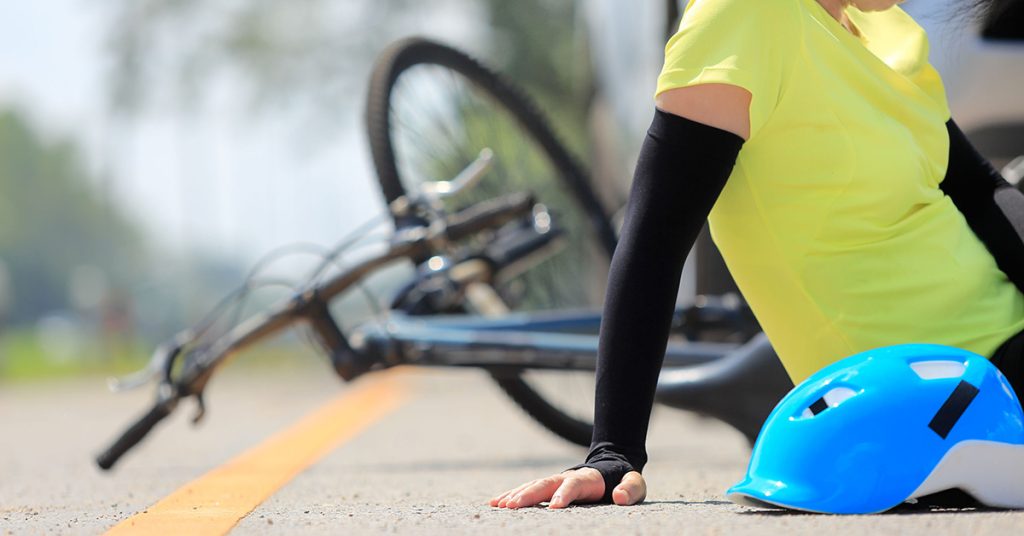Bicycle Accidents
Breakstone, White & Gluck’s Project KidSafe Campaigns Supports Boston Area Police Departments
In June, Breakstone, White & Gluck and our Project KidSafe campaign were pleased to donate children’s bicycle helmets to the Quincy Police Department, Brockton Police Department and the Braintree Police Department.
Read about our donation to Quincy Police in the Quincy Sun newspaper.
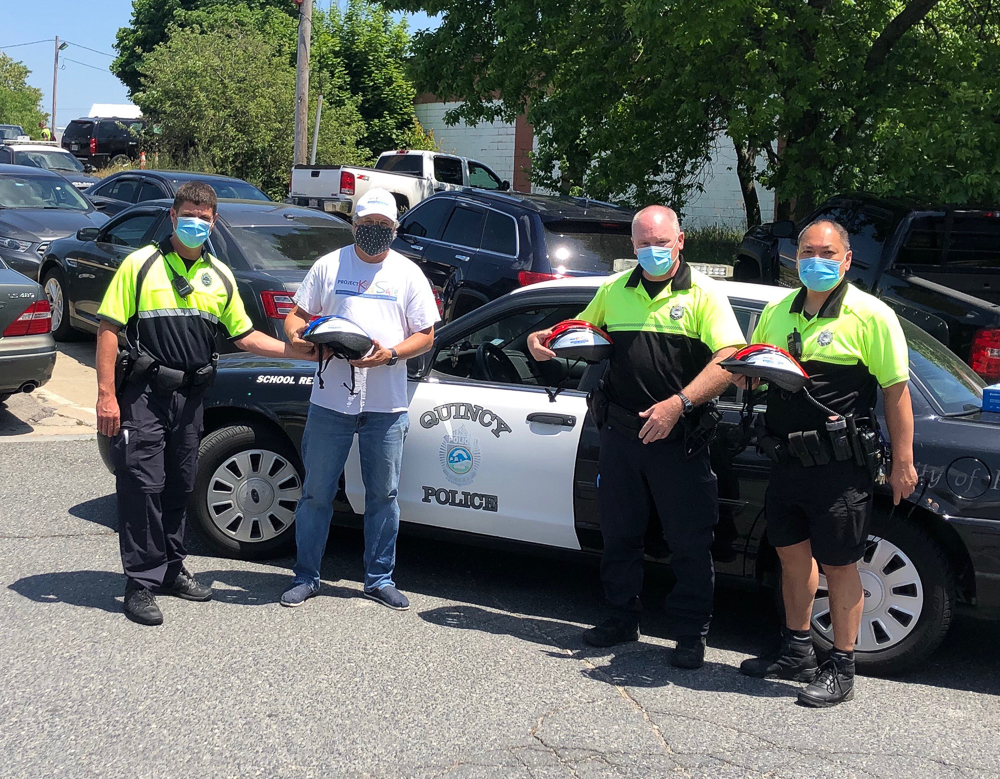
Breakstone, White & Gluck donated 200 children’s bicycle helmets to the Quincy Police Department, for distribution to local children in 2020. Pictured (L-R): Officer G. Hartnett, Atty. David White, Officer Whedbee and Officer Mar. Photo Courtesy Quincy Police Dept.
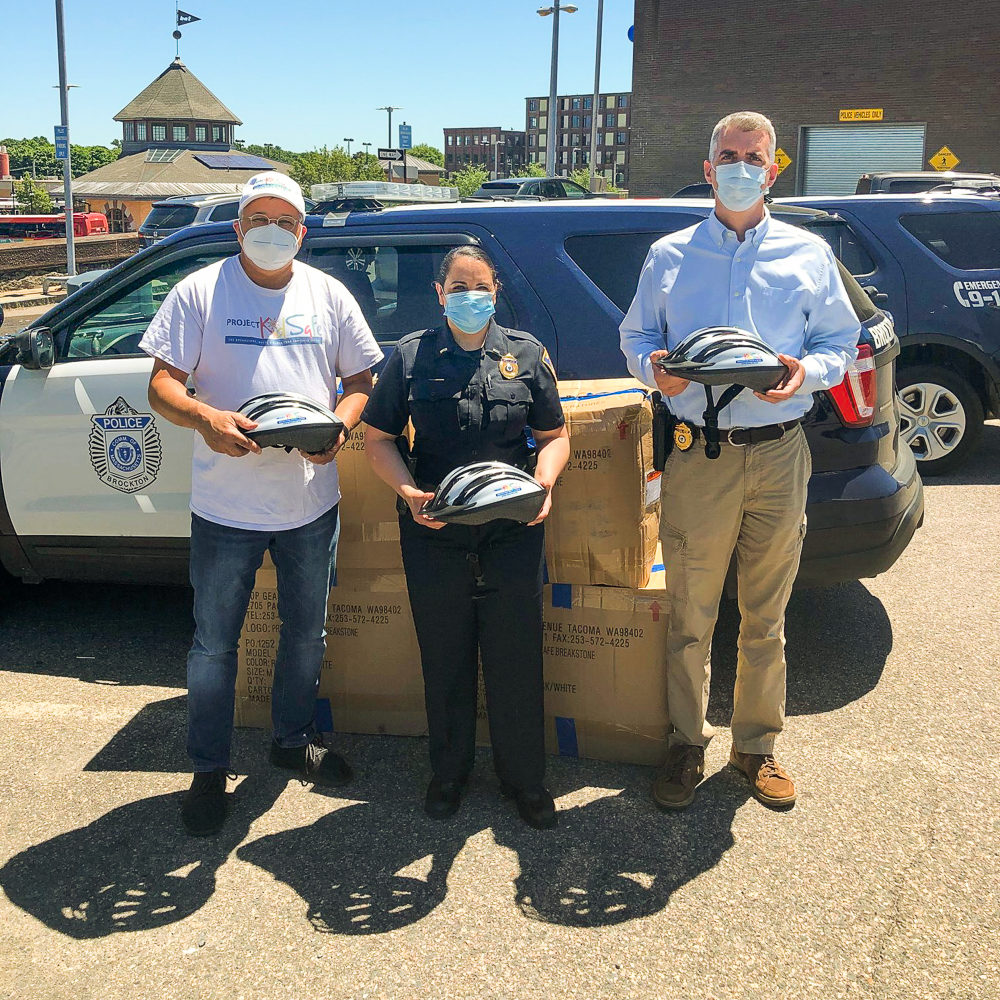
PHOTO COURTESY: Brockton Police Facebook– (From left:) Attorney David W. White, with Brockton Police Lt. Brenda Perez and Sgt. Will Schlieman
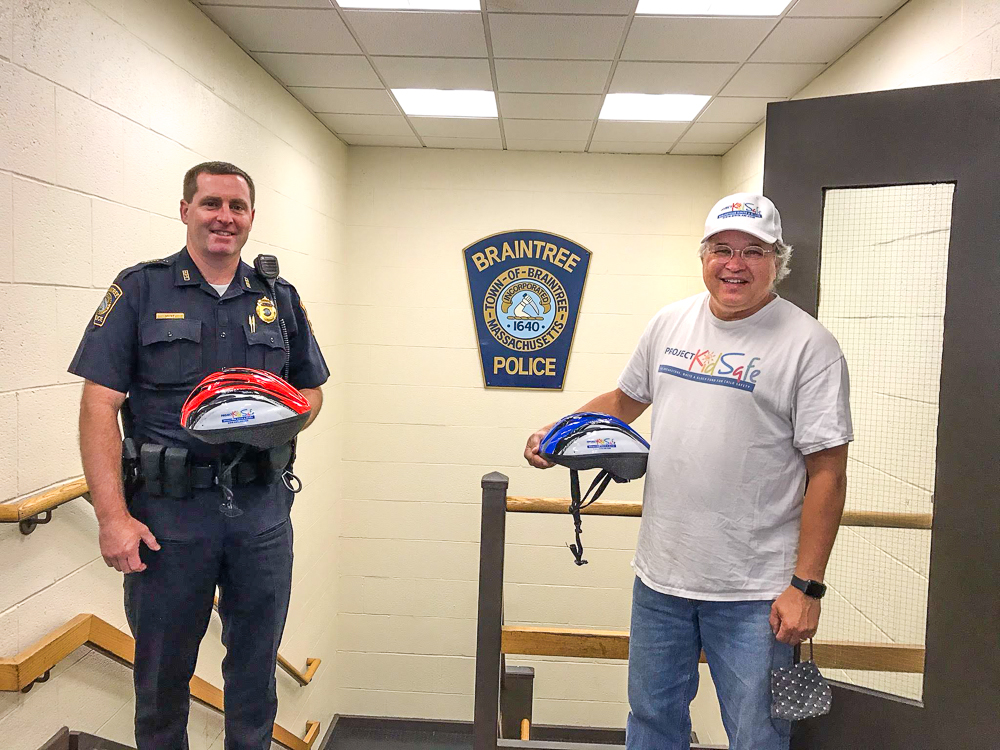
Left to right: Braintree Police Deputy Chief Michael Want receives Project KidSafe bicycle helmet donation and Attorney David W. White of Breakstone, White & Gluck.
About Breakstone, White & Gluck & Project KidSafe
Breakstone, White & Gluck is a top-rated Boston personal injury law firm serving all of Massachusetts. Our attorneys founded our Project KidSafe campaign in 2013, with a goal of protecting children from head injuries. Toward that goal, we have now donated 30,000 bicycle helmets to children in the Boston area, with help from more than 50 community partners.
Under Massachusetts law, cyclists who are 16 and younger are required to wear helmets to protect themselves. To learn more, we have posted a video and other materials on our website: www.bwglaw.com/project-kidsafe/.
Learn more about Breakstone, White & Gluck and our Project KidSafe campaign.
Massachusetts Safe Routes to School Recognizes Project KidSafe Bike Helmet Donation
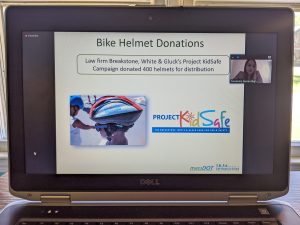
For the 6th year, Breakstone, White & Gluck and our Project KidSafe campaign are pleased to support Massachusetts Safe Routes to School. Once again, our attorneys have committed to donating 400 bicycle helmets to Safe Routes. From there, the Safe Routes coordinators will give the helmets to low-income children who want to participate in bike safety training and bike rodeos.
This morning, Massachusetts Safe Routes to School held its annual awards ceremony to honor schools and teachers which have excelled in reaching their walking and biking goals for children. Stephanie Pollack, secretary and CEO of the Massachusetts Department of Transportation (MassDOT), was the featured speaker. Before announcing the awards, Massachusetts Safe Routes to School thanked Breakstone, White & Gluck for our donation.
This is Massachusetts Safe Routes to School’s 15th anniversary. For those who don’t know, Massachusetts Safe Routes to School is a federally funded initiative of the MassDOT. Over 15 years, it has offered biking and pedestrian safety program to children in 237 communities and reached more than 420,000 students. Schools are committed to the programming. Safe Routes now has 920 partner schools. View this year’s awards list.
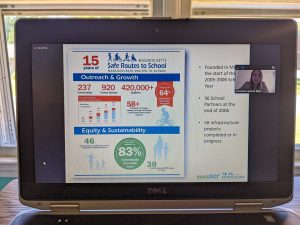 About Breakstone, White & Gluck – Commitment to Bike Safety
About Breakstone, White & Gluck – Commitment to Bike Safety
The Boston personal injury lawyers at Breakstone, White & Gluck are committed to safety and preventing head injuries. Through our Project KidSafe campaign, we have donated 30,000 children’s bicycle helmets across Massachusetts. We founded our campaign in 2013 and have since partnered with Massachusetts Safe Routes to School, local police departments, bicycle committees and community groups. Our goal has been to work with community partners who really care and are committed to bicycle safety and preventing head injuries.
In Massachusetts, cyclists under age 17 must wear bicycle helmets. But every cyclist is encouraged to wear a helmet. We hope you are never injured on a bike, but you can recover from many injuries. Head injuries can be fatal and it is important to protect yourself.
Commit to wear a bicycle helmet every time you ride. Helmet use has been estimated to reduce the chances of head injury by 50 percent and the chances of head, face or neck injury by 33 percent, according to the Insurance Institute for Highway Safety.
Distracted Driving Accidents Have Seriously Injured Cyclists in Massachusetts, Pennsylvania and Florida
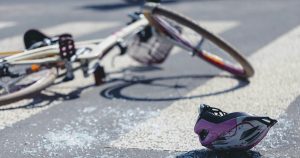
Over the past year, distracted driving accidents have seriously injured cyclists in Massachusetts and other states.
During the past few months, you may have noticed more bicyclists and fewer cars out. Massachusetts bike shops have confirmed that sales are way up since the COVID-19 emergency began. And during an uncertain time, it has been nice to see people enjoy bikes.
But now, as Massachusetts slowly re-opens the economy, driving patterns are changing again. More cyclists are out, but increasingly, so are cars. Coincidentally, traffic laws have also changed. As of April 1st, the Massachusetts hands-free driving law took effect, banning all hand-held cell phone use. Going forward, drivers must connect to voice-activated technology.
This is an important new law for cyclists, who often travel to the immediate right of a vehicle in the bike lane or roadside. When a driver doesn’t pick up a phone, this takes away an unexpected movement, a layer of danger to cyclists.
But several other layers remain. The reality is many drivers do not even realize cyclists are nearby. But cyclists are close and are vulnerable to your quick, unpredictable movements, such as when you pick up a cell phone, reach into your glove compartment or open a fast-food bag as you drive. Or when you tend to your children or other passengers.
If you are a Massachusetts driver, now is the time to set up your vehicle for hands-free cell phone use. Commit to follow the new law and drive safely.
Also commit to check for cyclists. When you stop at a traffic light or stop sign, check in front of you, to each side and behind you. Bicycle accidents often happen because cyclists are approaching from behind cars. Many drivers neglect to look there. Drivers are less likely to look if they are focused on their cell phone or texting while driving.
Many communities are expanding sidewalks or changing traffic patterns to make room for social distance. This means you may encounter cyclists in new areas. Approach slowly, with caution and patience.
Recent Cases: Distracted Driving Accidents and Injuries to Cyclists
Over the past year, there have been several news stories about distracted driving, leading to cyclist injuries and deaths. Even as states such as Massachusetts and Maine have strengthened laws, the number of distracted accidents continues to rise.
Ipswich Texting While Driving Crash Kills Cyclist
On March 26th, just days after the Massachusetts stay at home advisory took effect, there was a tragic crash on an Ipswich Road. According to the The Boston Globe, a 43-year-old driver fatally struck a cyclist in the North Shore community, also injuring two other family members on bikes. Ipswich Police and the Essex County District Attorney’s office announced the driver has been cited for motor vehicle homicide by negligent operation, marked lanes violation and composing, sending and reading an electronic message. A clerk magistrate will decide whether a criminal complaint will be issued.
Pennsylvania Driver Accused of Texting in Cyclist’s Death
In April 2019, a Pennsylvania woman was accused of texting while driving. Penn Live, a local news website, reported she struck a male cyclist in Mount Joy Township. Forensic analysis determined she had sent a text message a minute before the crash. She received a message, then tried to call 911, as a neighbor also called in.
The cyclist died from multiple traumas nine days later. In this case, the driver was charged with felony homicide by vehicle, misdemeanor involuntary manslaughter, and cited with traffic citations in the crash, according to Penn Live.
Florida Distracted Driving Case Ends in Fine, Community Service
In January 2020, a Florida woman pleaded no contest in a fatal crash which killed two cyclists and seriously injured several others. In November 2018, the woman had struck the group of 14 cyclists with her vehicle. They were members of a local bicycle club riding in Davie, a community in Broward County.
According to the Sun Sentinel newspaper, the woman admitted to reaching into her glove compartment for her cigarettes. She also said she was temporarily blinded by sun glare. Police allege the woman was also traveling 70 mph on a 55 mph road when she struck the cyclists. This was a horrific crash and many involved were deeply upset with the outcome. In this case, local prosecutors maintained the woman’s actions did not warrant a criminal charge of motor vehicle homicide, according to the Sun Sentinel. So the driver pleaded no contest to careless driving, leaving court with orders to pay a $1,000 fine and complete 120 days of community service. She also lost her driver’s license for six months.
Free Legal Consultation
Boston Bicycle Accident Lawyers – Distracted Driving Injuries to Cyclists
At Breakstone, White & Gluck, our Boston bicycle accident attorneys have more than 100 years combined experience. We represent cyclists and others who have been injured by distracted driving, including a driver’s negligent use of a cell phone.
Distracted driving accidents can seriously injure cyclists. We urge you to act right away if you suspect a driver’s cell phone use may have caused your injuries. If you or a loved one was injured, it is important to consult an experienced lawyer to learn your rights. You may be entitled to pursue financial compensation for your medical bills, lost wages, pain and suffering and other financial losses.
For a free legal consultation, contact Breakstone, White & Gluck at 800-379-1244 or 617-723-7676. You can also use our contact form.
In Massachusetts, Less Traffic Congestion, But Drivers are Speeding Dangerously Down Open Roads
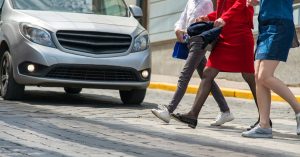
In Massachusetts, traffic is lighter during the COVID-19 emergency, but drivers are being warned to slow down.
During the COVID-19 emergency, Massachusetts residents are getting an unprecedented look at life without traffic congestion. With fewer cars out, there have been fewer accidents. But the drivers who are out have been speeding down open streets. State transportation officials say the high speeds are contributing to traffic fatalities.
The rate of traffic fatalities doubled in April, when traffic dropped by 50 percent on some highways, according the Massachusetts Department of Transportation (or MassDOT). The Boston Globe reported that 28 people died in April, compared to 27 during April 2019, when there was no disruption to traffic.
Speeding and distracted driving have contributed to fatal accidents. According to MassDOT, the fatal crashes resulted in the deaths of drivers, passengers, two motorcyclists and three pedestrians. In Boston, a cyclist was killed by a large truck near Massachusetts and Harrison avenues.
In Boston, Mayor Marty Walsh urged drivers to slow down during his briefing last week. News briefing posted May 1.
“With less traffic, what we’re starting to see is increased speed,” Walsh said. “So the crashes that do happen have been more severe due to the high speed impacts. Even an increase of four to five miles per hour can make a big difference in terms of injuries and possible death.”
The MassDOT did not provide overall crash data for last month. Preliminary data shows two-thirds of crashes happened on local roads.
When traveling in their communities, drivers must remember that they share the road with cyclists and pedestrians. Right now, there are more people out, of all ages. It is essential to stop at crosswalks, yield to pedestrians and drive slowly.
It is also essential to watch for cyclists and practice situational awareness, especially when turning at intersections. Remember that cyclists are allowed to travel in bike lanes, on the right side of the road or in the middle of the lane if necessary for safety. Because cyclists may need to change their lane (for example, to avoid an illegally parked car), it is important to provide cyclists with ample room to make safe decisions.
Just How Slowly Should You Drive?
As a first step, commit to follow the speed limit or travel even slower when necessary. By doing so, you leave yourself more time to stop and prevent a crash before it happens.
It is important to remember that you control your speed and research has found fatal injuries are less likely at lower speeds. Consider a driver who was traveling at 40 mph and hit a pedestrian. There is a 73 percent likelihood that the driver will cause the pedestrian severe injury or death, according to the Vision Zero safety campaign. At 30 mph, the risk for severe injury or death is reduced to 40 percent. At 20 mph, there is a 13 percent likelihood of causing severe injury or death.
Fewer Drivers, Fewer Tickets and Fewer Car Accidents
The Boston Globe reported on Massachusetts traffic activity on April 30th. As the state responds to COVID-19, there has been a dramatic decline in traffic, citations and accidents.
From March 23 to April 26, more than 2,600 car accidents were reported across Massachusetts. 12,000 car accidents were reported during the same period in 2019.
Another measure of driving activity is usually traffic citations or moving violations, such as speeding and parking violations. But during the first three weeks of April 2020, as residents stayed home and law enforcement responded to COVID-19, Massachusetts police departments issued 95 percent fewer tickets for moving violations compared to the same period in 2019.
While traffic remains light overall, Massachusetts State Police have also observed a “significant surge” in drivers speeding more than 100 mph, according to the Globe. Specifically, drivers have also complained about speeding on the MassPike. Now, the agency plans to increase patrols at random times and places.
Breakstone, White & Gluck – Boston Car Accident Lawyers
Free Legal Consultation
Breakstone, White & Gluck represents those who have been injured by the negligence of others in Massachusetts. Our personal injury attorneys provide experienced representation after motor vehicle accidents, including car accidents, truck crashes, pedestrian accidents and bicycle collisions.
Learn your legal rights after an accident. For a free legal consultation, contact Breakstone, White & Gluck. Call 800-379-1244 or 617-723-7676 or use our contact form.
COVID-19 Safety for Cyclists and Pedestrians in Boston and Massachusetts

Massachusetts safety groups share COVID-19 advisories for cyclists and pedestrians.
At Breakstone, White & Gluck, our attorneys encourage you to follow the Massachusetts “stay at home” advisory. When you go out for essential errands, the CDC advises you to wear a face mask and follow social distance guidelines, staying at least 6 feet apart from other people.
Yet it is also important to get outside for a few minutes of fresh air each day, even if you just stay in your own yard or walk down the street. With many of us so distressed, this can be hard to do, but if you are healthy and able, we have compiled these safety tips from the CDC, the Massachusetts Covid-19 website and bike and pedestrian groups we support.
Massachusetts Stay at Home Advisory
State officials have advised light exercise, such as a walk or run around your neighborhood, is acceptable but you have to follow social distancing and other guidelines. Playing close contact sports with others is against the state guidelines. Mass DPH Health Advisory: Stay at Home (March 24, 2020).
MassBike
MassBike issued a COVID-19 safety update, dated April 19, 2020, saying its response has generally been to follow the Massachusetts Governor’s Office and the Centers for Disease Control. Cyclists can ride, “But MassBike certainly agrees with, and wants to reiterate, the official message of #StayHomeSaveLives. We encourage you all to stay home as best you can.”
MassBike’s safety tips included:
- Never ride if you are ill or are experiencing of COVID-19.
- Ride solo or only with others you live with.
- Wear a mask.
- Carry your supplies so you can avoid stopping and and interacting with people.
- Look for a place where others are not riding.
- Ride with caution.
The CDC recommends people stay at least six feet apart, but how can you measure distance when you are moving? That’s a good question and in its post, MassBike mentioned a Belgium study on social distancing on bikes. The study advises people to walk about 12-15 feet away to maintain safe social distancing or about 30 feet for running and slow biking. When cycling fast, bicyclists should keep at least 60 feet apart.
Boston Cyclists Union
The Boston Cyclists Union says yes, cyclists can still ride. If you do, the organization recommends riding alone or only with others in your home. It also suggests wearing a mask to protect yourselves and others. Read the Boston Cyclists Union advisory, April 1, 2020.
WalkBoston
WalkBoston released an update on March 27, 2020. It also warned the public to practice social distancing when walking. The organization, active in Boston and across Massachusetts, offers a weekly email newsletter.
Massachusetts City and Town Advisories on Expanded Recreation Areas
Some communities are talking about opening up roads so pedestrians and cyclists have more room to exercise and follow social distance guidelines. In Brookline, the Transportation Board removed parking and traffic lanes and opened up parts of Beacon Street, Brookline Avenue and Harvard Street to pedestrians.
The City of Boston also closed three Department of Conservation and Recreation (DCR) parkways to traffic, giving pedestrians and cyclists more room. These include the William J. Day Boulevard, Francis Parkman Drive and Greenough Boulevard.
In Cambridge, the City Council was also considering closing roads along Memorial Drive.
Final Note:
In addition to taking COVID-19 safety precautions, cyclists must remember to follow fundamentals, such as always wearing a properly-fitted helmet and using rear and front lights on your bike. If you need a new helmet, supplies or a tune-up, local bike shops are considered “essential businesses” and are allowed to open. Finally, both cyclists and pedestrians can protect themselves by wearing brightly colored clothing or a neon safety vest to stand out. While traffic has decreased on many roads, there are still many drivers out and it’s important to be vigilant about safety.
If you are interested in learning more about bike safety, consider checking out our articles:
Other COVID-19 Resources
CDC Advisory on Protective Face Masks
State of Massachusetts COVID-19 Updates
Consumer Reports, “Bike Riding Safety During the Coronavirus Pandemic,” April 10, 2020
Free Legal Consultation – Boston Personal Injury Lawyers
Breakstone, White & Gluck supports cycling and pedestrian safety in Massachusetts. Through our Project KidSafe campaign, we are committed to protecting children on bicycles from concussions and traumatic brain injuries.
If you have been injured, learn your legal rights. Breakstone, White & Gluck represents those injured by negligence and recklessness throughout Massachusetts, including in car accidents, truck accidents, motorcycle accidents, bicycle accidents and pedestrian accidents. For a free legal consultation, contact us at 800-379-1244 or 617-723-7676. You can also use our contact form.
Encouraging Boston Drivers to Look For Cyclists
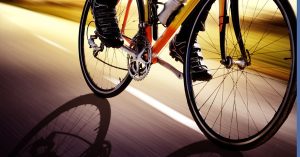
Safety reminders for drivers as cyclists return to the road in Boston.
In Boston, many cyclists take a winter break. As this nears an end, drivers should get ready to commute alongside cyclists again. Everyone should be aware of the risks for bicycle accidents at intersections. These include right hook accidents, which occur when a driver fails to yield to a cyclist while turning right.
Drivers must remember that cyclists have the same rights and responsibilities as drivers. Here, we share a few safety tips for drivers from the National Highway Traffic Safety Administration (NHTSA):
- Obey the speed limit.
- Drive defensively. Cyclists may need to leave their lane for safety reasons and may not give you much notice.
- Yield to cyclists just as you would another motor vehicle.
- When turning right on a red light, check for cyclists to the right and behind you. Stop completely and look in both directions – left, right, left and behind.
- Provide cyclists with adequate space.
- Pass cyclists with care. Do not pass too closely and only do so if you would pass a motor vehicle in the same situation.
- Check before you pull out or back up in parking lots.
- Check for cyclists when at stop signs. Expect that a cyclist may come up behind you while you wait for your turn to go.
Driving Safely Near Bicyclists in Massachusetts
Gone are the days when drivers rarely saw a cyclist on the road. It’s critical for drivers to be informed about their responsibilities near cyclists, particularly in intersections, and the potential for bicycle crashes.
As a driver, if you are near a bicyclist, the best approach is to slow down and give them room. Do not take your eyes off the cyclist or the road. If you don’t see a cyclist, take the opportunity to look.
Leave the bicycle lane for cyclists – this is the law in Massachusetts and if you neglect to follow it, you could hit a cyclist, causing serious injury and confusing other drivers. And this could lead to domino-effect collisions with other vehicles, cyclists or pedestrians in the area.
Expect cyclists will be traveling in front of you, as well as behind you. In fact, they are more likely to be behind you, to the right (though they are allowed to travel in the center of the lane in Massachusetts if they need to). Checking your mirrors is essential, as is left-right-left and behind checking. This is true even after you park because cyclists could be riding by and by opening the door at the wrong time, you could cause a bicycle dooring injury.
Finally, remember cyclists may not be visible behind commercial trucks and other traffic. The cyclist may be out of your view, but just approaching the large vehicle behind you. If the vehicle behind you is obstructing your view, take an extra few seconds.
For more information, read our articles, “Facts About Bicycling Laws in Massachusetts,” or “Tips for Safe Bike Commuting in Boston.” You can also visit the MassBike website, which explains more about cyclist and motorist responsibilities or the NHTSA web page on bicycle safety.
Free Legal Consultation – Boston Bicycle Accident Attorneys
Breakstone, White & Gluck has extensive experience handling personal injury cases involving bicycle injuries in Boston and across Massachusetts. After a bicycle accident, our attorneys are here to provide clients with thorough investigation and aggressive representation. We understand the stakes are high when you have been injured on a bicycle because medical bills can mount quickly and no one expects to suffer an injury. But we have attorneys who are experienced as lawyers and as cyclists. We are committed to partnering with our clients to obtain the best financial result in every case.
For a free legal consultation, contact Breakstone, White & Gluck at 800-379-1244 or 617-723-7676. You can also use our contact form.
Massachusetts Lawyers Weekly Mentions Breakstone, White & Gluck’s Project KidSafe Campaign
Massachusetts Lawyers Weekly recently gave Breakstone, White & Gluck and our Project KidSafe campaign a nice mention. In 2019, our campaign donated over 4,000 bicycle helmets to children throughout the Boston area with help from more than 30 community partners and police departments. We look forward to continuing our work to protect children in 2020.
Read the article on the Massachusetts Lawyers Weekly website (subscription access required).
Buying Your Child a New Bike, Scooter or Snowboard This Holiday? Don’t Forget the Safety Helmet

Give the gift of safety. Always give a helmets to go with new bicycles, scooters and other riding toys.
It is a lot of fun to select a new bicycle or scooter for a child during the holiday season. But when you buy, remember to pick up a new helmet, too. This is a critical tool in protecting against head injuries and under Massachusetts law, children 16 and younger are required to wear helmets on bicycles, scooters, skateboards and inline skates.
Massachusetts Bicycle Helmet Law: Children 16 and younger are required to wear bicycle helmets when they ride bikes in Massachusetts, under M.G.L. c. 85, § 11B.
Massachusetts Scooter Helmet Law. M.G.L. c. 85, § 11B1/2 states children 16 and younger must also wear safety helmets on scooters, skateboards and inline skates, as well as other manually-propelled wheeled vehicles.
Helmet Buying Tips: Spotlight on Bike Helmets
Buy a bicycle helmet which meets the safety standards set by the U.S. Consumer Product Safety Commission (16 C.F.R. part 1203). This standard is specifically designed to protect a child’s head with shock-absorbent material in bicycle accidents or falls. It requires chin traps be strong enough to keep the helmet in position on the head.
Buy a helmet separately from your bike. You may find it helpful to buy a helmet separately. To get started, measure around your child’s head with a cloth tape measure. Measure just above your child’s eyebrows. Start looking now online or visit your local bicycle shop.
Stick to traditional bike helmets. The CPSC discourages parents from buying helmets with decorative and costume pieces, such as horns or parts which protrude from the helmet. These will interfere with the helmet’s ability to protect a child’s head should they ever hit the ground.
How long has your child been wearing that helmet? If your child has been wearing a helmet for three years, this is a good time to buy a new one. But depending on your child’s growth and wear and tear, you may want to replace it sooner. Carefully inspect the helmet on the inside and outside.
Buy an adjustable helmet. Because children grow fast, we suggest an adjustable helmet which can be tightened or loosened in the back.
Helmets Designed for Other Activities
Safety helmets are designed for certain purposes. Each sport and activity involves a different impact.
But bicycle helmets can often be used for recreational in-line skating, roller skating or manual kick scooters, according to the Consumer Product Safety Commission’s (CPSC) helmet guidelines. Check these guidelines whenever you buy a helmet.
Talk to your child’s sports coach about helmet guidelines for football, hockey, lacrosse and baseball.
Get your helmets ready for the winter. Helmets are recommended for skiing, snowmobiling, snowboarding and snow tubing. Many skiers say helmets interfere with their peripheral vision and response time. If this is your thought, consider reading this New York Times blog on just how much protection they can provide.
Before we close, another point is there are times when children should definitely NOT WEAR HELMETS, including at the playground or when playing at home. Helmets and straps can get caught and strangle a child on staircases and step ladders.
CPSC Guide – “What Helmet for Which Activity”
Helmets are essential to protecting your child. Here is the CPSC’s Guide, “Which Helmet for Which Activity.” This guide provides you with recommended safety standard guidelines for different activities, so it’s definitely worth bookmarking. Another helpful site is the CSPC recalls website, which you can search for product recalls before you make a purchase.
About Breakstone, White & Gluck
Boston Personal Injury Lawyers – Toy Safety Lawyers
 At Breakstone, White & Gluck, our lawyers are consistently recognized for their awards for clients in personal injury, medical malpractice and product liability cases. Through our Project KidSafe campaign, we work to promote bicycle safety and the well-being of children in Massachusetts. To date, we have donated over 25,000 bicycle helmets to children across the state.
At Breakstone, White & Gluck, our lawyers are consistently recognized for their awards for clients in personal injury, medical malpractice and product liability cases. Through our Project KidSafe campaign, we work to promote bicycle safety and the well-being of children in Massachusetts. To date, we have donated over 25,000 bicycle helmets to children across the state.
If you are shopping for a child, we invite you to read more of our holiday toy safety series.
In the Battle for Safety, Cambridge Lowers Speed Limits to 20 MPH

Drivers, double check your speed next time you visit Cambridge. In mid-November, the city plans a slow down to 20 mph on most city-owned streets. The city says, when in doubt, go 20 mph.
The City of Cambridge announced the new 20 mph speed limit this week, a decision made in response to residents’ concerns about speeding vehicles and the risk for pedestrian accidents and injuries to cyclists. Cambridge follows Boston and Somerville in pursuing 20 mph speeds on certain city streets. Each city has a VisionZero safety campaign and is working to eliminate traffic fatalities.
Cambridge first lowered speed limits from 30 to 25 mph on most city-owned streets in December 2016. The Massachusetts Legislature granted cities and towns this authority earlier that year with passage of the Municipal Modernization Law. Specifically, communities were given the authority to lower speeds from 30 to 25 mph in locally-owned thickly settled areas.
In response, dozens of communities adopted 25 mph speed limits to reduce the risk of accidents. Few have pursued 20 mph – yet.
But according to the City of Cambridge’s announcement, the law allows communities to establish 20 mph “safety zones” in the interest of public safety. Cambridge will be installing 660 new “safety zone” signs.
The City of Somerville has also taken advantage of this provision of the law. Last we knew, the City of Boston – which was the first to pursue 25 mph, then 20 mph speeds – was still working on the issue. Here is our last update on Massachusetts speed limits (though please note: there may have been additional action since then).
Check a street: Not every street in Cambridge will be impacted. Larger streets like Brattle Street and Cambridge Street will stick with current speeds. Roads under state management – such as Memorial Drive – will not change. You can check out the map here: www.cambridgema.gov/20mph.
It’s worth noting Cambridge’s squares – including Harvard Square, Lechmere Square and Porter Square – won’t see any change. The city lowered speeds to 20 mph back in early 2018.
Cambridge’s Influence on Traffic Safety
Cambridge has been ambitious in making traffic safety improvements. In addition to lowering speeds, the city announced a new City Safety Ordinance earlier this year. The city made the commitment to add permanent separated bike lanes whenever it reconstructs roads identified in the Cambridge Bicycle Plan. With full build out, this would give the city an impressive 20 miles of protected bike lanes. Cambridge Bicycle Safety, a local group, said this could reduce 40 percent of Cambridge bicycle accidents, the one which occur outside intersections.
The city, while committed, does concede there may be cases when these bike lanes aren’t possible due to road conditions.
The bottom line is Cambridge has such a strong influence on transportation in the Boston region, just by virtue of its geography. It borders Somerville, Boston, Arlington, Belmont and Watertown. And because it’s one of the largest cities in Massachusetts, its work to promote safety will be watched across the state and nationally.
Free Legal Consultation – Boston Pedestrian Car Accident Lawyers
Breakstone, White & Gluck has represented accident victims in Boston, Cambridge and across Massachusetts since 1992. Our attorneys are dedicated to our clients and our results. We provide the prompt and thorough investigation required after pedestrian car accidents and bicycle crashes.
If you have been injured by a driver, we offer a free legal consultation to advise you on whether you may pursue a financial claim for your injuries and other losses. Consult one of our personal injury attorneys today at 800-379-1244 or 617-723-7676. You can also use our contact form.
Bicyclist and Pedestrian Deaths Keep Rising
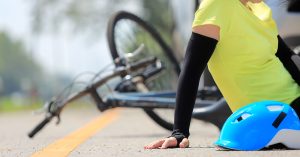 New federal data shows a 2.4 percent reduction in overall traffic deaths last year. But that’s not the full story. The roads were not any safer for pedestrians and bicyclists last year. These groups saw an increase in deaths, now making up nearly 20 percent of all traffic deaths. Many say it’s time to accelerate the conversation on safe road design.
New federal data shows a 2.4 percent reduction in overall traffic deaths last year. But that’s not the full story. The roads were not any safer for pedestrians and bicyclists last year. These groups saw an increase in deaths, now making up nearly 20 percent of all traffic deaths. Many say it’s time to accelerate the conversation on safe road design.
The Washington Post recently reported on the new data, which comes from the National Highway Traffic Safety Administration (NHTSA)’s Fatality Analysis Reporting System.
It shows nearly 36,600 people died in traffic accidents in 2018, a 2.4 percent decrease from 2017, according to The Washington Post. Traffic experts cite several areas of progress. There were fewer deaths caused by speeding and drinking and driving, and a 10 percent reduction in children’s fatalities. Motorcycle fatalities also declined about 5 percent.
What remains troublesome is bicyclists and pedestrians are at high risk. Bicycle accidents and pedestrian accidents are claiming more lives than ever – about 20 percent of all traffic deaths combined. This is a sharp rise, particularly in pedestrian deaths. Just 10 years ago, pedestrians made up 12 percent of all traffic deaths. They now represent 17 percent of all traffic fatalities.
The data shows that 6,283 pedestrians were killed in 2018, a 3.4 percent increase. Another 857 people were killed on bikes or similar non-motorized vehicles, a 6.3 percent increase.
With this new data, many are considering our nation’s antiquated roads, which the Governors Highway Safety Association says were not designed to accommodate so many pedestrians and bicyclists. Over the past decade, cities have encouraged walking and biking as a way to beat the traffic congestion. But use has far exceeded the visions of planners, especially when you considered developments, such as bike-shares, e-scooters and self-driving cars.
The Governors Highways Safety Association further stated that a combination of initiatives would be necessary to improve safety for pedestrians and cyclists, from road engineering to educational approaches.
Pedestrian and Bike Safety in the Late Fall in Massachusetts
This is a challenging time of the year for bike commuters and pedestrians in Massachusetts. The days are getting shorter and darker. And you have to be aware of the statistics. According to the NHTSA data, about 76 percent of pedestrian traffic fatalities occur after dark.
If you walk, consider keeping a neon safety vest in your work bag. Wear it when you go to work and as you leave work. Continue to use crosswalks with traffic signal buttons. Cross with other people.
If you ride your bike, wear your bike helmet and use bike lights. Bike lights are required under Massachusetts law. You must have a white light in front of your bike and a red light in back. Read our article, Facts About Massachusetts Bicycle Laws, to learn more.
Free Legal Consultation – Boston Pedestrian and Bicycle Accident Lawyers
With more than 100 years combined experience, Breakstone, White & Gluck is a leading personal injury law firm in Boston. Our attorneys specialize in representing those injured in motor vehicle accidents, including pedestrians and bicyclists, in Boston, Cambridge and across Massachusetts. If you have been injured, learn your legal rights for seeking financial compensation for your losses, including medical expenses, lost wages and pain and suffering. For a free legal consultation, contact us at 800-379-1244 or 617-723-7676 or use our contact form.


